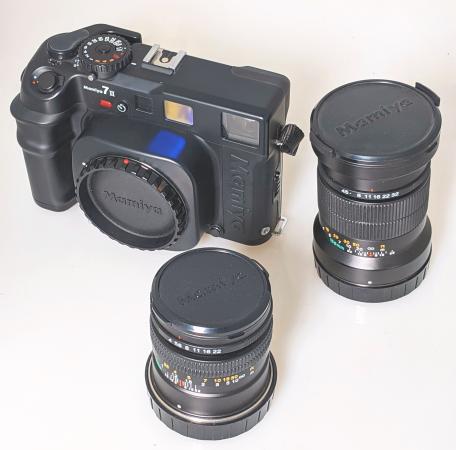
A prototype lens of 90 3.5 M L-A with floating system also exists. 24 mm equivalent 65 mm f/4, two versions (the second one has a floating element), 32 mm equivalent 75 mm f/3.5, with floating element, 36 mm equivalentĩ0 mm f/3.5, with extension tubes 1 and 2 has the largest magnification of all RZ67 lenses, able to shoot 1.92:1. Two versions exist, the non ULD and ULD L (contains floating element), the ULD version is clearly marked. ULD glass, floating system and aspherical. There are a wide variety of lenses available for the RZ67:Ĥ3 mm f/4.5.
#Mamiya 7 ii case pro#
RZ67 Pro II, not much exterior difference between the models except the Pro II version has a critical focus knob. In addition, the RZ67 has plastic exterior body, which makes it somewhat lighter.

The RZ67 has also mechanical couplings between the parts, but the shutter is electronic, and parts are able to transmit exposure information with electronic couplings. The biggest difference between RB67 and RZ67 is that the RB67 is completely mechanical. In RBL compatibility mode, the RZ67 is able to use RB67 lenses.
#Mamiya 7 ii case manual#
In addition to manual operation (photographer chooses aperture and shutter speed), the RZ67 is able to operate in AEF mode with an AE viewfinder (AE being an abbreviation for automatic exposure), which transmits exposure information directly to the body. The viewfinder also hosts LEDs informing of the state of the camera (flash ready, low battery, dark slide not removed, shutter not cocked). The orientation is shown in the viewfinder with black guides. The RZ67 name is adopted from the model name of the Mamiya RB67 (in which RB stands for "Revolving Back"), which was first introduced in 1970, thus the RZ67 also takes backs which can be rotated 90 degrees to provide a horizontal or vertical composition. The body has one standard flash hot shoe on its left side, one plug for a standard remote shutter cable release, and a socket for an electronic shutter trigger. Multiple exposures are possible in the M-mode. It can be used in emergency mode fully mechanically with a fixed 1/400 sec shutter speed. The RZ67 operates on one 6 V silver oxide 4SR44 battery, or 6 V 4LR44 alkaline battery. There are two versions of the 6×7 and 6×4.5 backs the model II versions have a second film counter to always show the film count on the top. The film speed is set on each RZ back via a dial. Mamiya RB67 backs are also supported via the G-Adapter. The camera accepts 6×7, 6×6 and 6×4.5, 120 and 220 film magazines and Polaroid as well as Quadra 72 4×5 sheet film backs. Focusing is performed with a bellows on the body instead of the lenses. The RZ67 Sekor lenses have built-in electronic leaf shutters which are cocked and triggered from the body.

It is primarily designed for studio use, but can also be used in the field. RZ67 is a modular camera system, meaning lenses, viewfinders, ground glasses, film winders and film backs are all interchangeable.
#Mamiya 7 ii case professional#
There are three successive models: the RZ67 Professional (first model released in 1982), RZ67 Professional II (released in 1993) and RZ67 Professional IID (released in 2004). The Mamiya RZ67 is a professional medium format single-lens reflex system camera manufactured by Mamiya. 4LR44 6 V battery or 4 LR44 1.5 volt batteries


 0 kommentar(er)
0 kommentar(er)
